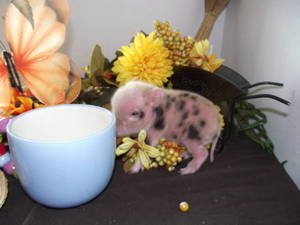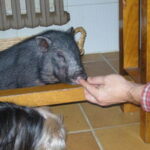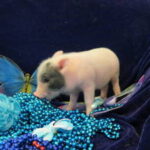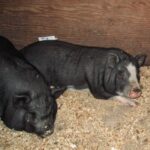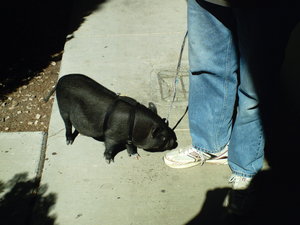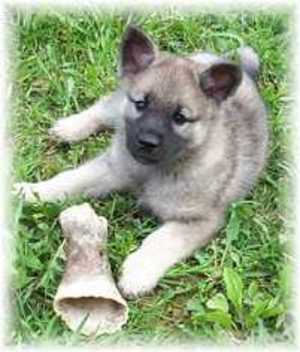My Cute Lovely Teacup Pig Sherlock
After mulling over for a long period of time if I should get a teacup pig or not, I’m finally getting one on that sunny April day. But this decision has not been made without extensive research. I poured over everything I can find over the Internet about teacup pigs and learned that they come in different names: mini pigs, miniature pigs, micro pigs, nano pigs, pot-bellied pigs etc. – all refer to their sizes and does not mean that they have different types. There’s a small difference between teacup and pot-bellied pigs as the later tends to grow bigger up to 200 pounds (lbs.) compared to teacup piggies which can only grow from 20-40 pounds (lbs.) in size.
Now, there’s a big discussion over the sizes as some breeders lie about how big or small (depends on how you look at it), can a teacup pig grow. A lot of buyers get disappointed when they find out that their piggies don’t stop growing. Even if they try to put their piggies under a strict diet, they naturally want to eat all the time. Starving them is out of the question as it will be animal cruelty and the owners have no choice but to adjust to the growth of their tea cup pig. There are times though that it leads to pot bellied pigs being neglected or abandoned as the owners do not know how to handle them anymore. I’ve read about stories where the pigs end up in rescue homes because their owners do not want to have anything to do with them. This made me more wary if adapting a piggy into our home would be sensible or not. And I got very particular in avoiding this scenario so I labored long to be able to choose the right sized teacup pig. In my pursuit to find the best and most genuine teacup pig, I prodded on to understand more how the selection of teacup pigs should be done to ensure that I’ll get the right breed.
I’ve found informative advice in a Hubpages teacup pig article and other resources which helped me learn that the best guarantee to get hold of genuine teacup pigs is to look for a reliable seller. Although it’s not really a 100% guarantee, reading testimonials about an online mini pig seller would still help. I get to understand how they handle their customers and how they breed their pigs. This is very useful for me actually because I don’t have friends or family members who have owned teacup pigs in the past. All I’ve come across are those popular celebrities holding their piggies in photos and can’t help but think how lovely these cuties are.
Here’s a rundown on how to avoid scams based on my readings so far:
- ·. It is difficult to breed these miniature pigs and the maintenance of their parents cost a lot so it’s just natural that most sellers only sell above the $1,000 range.
- · Teacup growers who do not want to let you see their breeders or adult pigs may just be hiding something. If they want to ease your worries about overgrown mini pigs, they should take away your wariness by showing you evidence.
- · Keep away from sellers who give promises that they miniature pigs will just simply grow under 15 lbs. or less. Nobody can rightfully predict how much a teacup pig can grow so the least they could do is give an estimate.
There are also plenty of videos available on YouTube and every time I watch them, I simply fell in love with these adorable little pigsies and I’d instantly want to go buy myself one. So when we arrived at the breeder’s place, we were shown a whole lot of them and together with my husband, we singled out a beautiful small micro pink and black female from the litter and asked how old was she. The breeder replied that all they’ve shown us are already mature enough to be taken to homes so I just need to pick one, pay for it and welcome the little darling to our family. And yes, we’ve also come prepared for the cost of purchasing a new piglet. We paid $2,475 for our newest family member and although it is somewhat pricey, I know that the fun and companionship she’ll give us will be worth it. All I really did was save a part of my income for about 3 months, while doing my research so the cost did not affect our monthly budget.
On the way back while driving, my husband and I discussed the little piggy’s name and since we’re both fans of Sherlock Holmes, we unanimously agreed to name the piglet Sherlock even if she’s a girl. I got so giddy even with that naming decision alone! With months of preparing for the arrival of this new family member, our home has already been “teacup pig proofed” days before and I immediately placed her on Sherlock’s corner as we now call it. I’ve also learned lots of littering guides online and I’d like to share how my experience with Sherlock went during our potty training sessions.
Although me and my hubby wanted to potty train our piglet outdoors, we also understand that this will be difficult for her because she has a lot of things to adjust inside our house first. So we bought a large litter box, much the same as that used by puppies and placed wood pieces inside. This will serve as Sherlock’s potty area for the meantime because we are still going to potty train her outside once she gets old enough and when we’ll feel that she’s ready for another feat. I then started feeding her and giving her a drink at around 9AM every day; this is a full meal and then I would check in the afternoon if she needs to feed more. Just before night sets in at around 6PM or so, I try to get her to do it by placing her to the potty box and saying the words “Sherlock potty” over and over again. However, teacup pigs have their own way of course, so it was not until morning that I discovered Sherlock chose to do it outside of her sleeping quarters. I got some of the waste and put it on the litter box and nudged her to the area so that she will somewhat understand the purpose of the litter box. All the while, I was repeating Sherlock potty, Sherlock potty to her ears and saying it gently. Afterwards, I fed her again and brought her to the litter box at the same hour of 6PM. It was hard work at first but I was patient and understanding since I treated her as a baby. This is actually very important during potty training because punishing is never recommended, but positive reinforcement will certainly do the trick. After about a week, I finally succeeded in letting her understand that the right area to do her thing is in her litter box. However, be warned those of you who are still planning to buy a new mini pig, constant training should be enforced for the piglet to adhere to her training at all times. Sure, I’ve gotten Sherlock to be disciplined on where she should move bowels, but there are just times that she may not go to the litter box. Whatever the reason maybe, just be prepared for such scenarios and be willing to remind her of her training.
All this time, I’ve been learning wonderful things from Sherlock too. I know they love to be cuddled and given attention so I always call her name whenever I’m around her area. I also bring her around the house so that she gets familiar with everything and get to feel really at home. I’m really very happy that I decided to buy this pet because I’m having so much fun training and giving her TLC. I’ve noticed though on the first week of being in our home that she tends to sleep most of the time. I was not concerned about it at first because I thought it’s just because she is still in her growing years. However, after about a month of being with us, this behavior of sleeping for a long time continued. Luckily, I’ve already scheduled with our nearest neighborhood vet to check out Sherlock. I had the appointment set up weeks before when she just recently arrived in our house. The vet found out that I was giving her the wrong types of food and that these are most likely the cause of her overlong sleeping. He then recommended the right diet for Sherlock along with the list on specific brands. Pigs needed protein and they can’t just get it on any food. They need to be fed with pig chow that has a high formulation of protein. If they are staying in the wild, they may get their protein supplement from worms, bugs and dead animals. This means that they have to be fed with pig chow regularly and not just pure vegetables and fruits. However, it is up to me as the owner to vary these food variants so that Sherlock will get a balanced diet and avoid getting her overweight. The vet also advised against overly giving treats as these can make teacup pigs wanting more and may let them become spoiled. He said that like everything else, moderation is the key so when we went home that day, I immediately started the right diet plan for Sherlock. And although my husband and I love giving her treats, we started to slow it down and only award her with treats if and when it is really worth it.
Here are some important insights I’ve learned about giving mini pigs treats and I hope you’ll be able to apply it to your piglet too. Most of the treats available in the market are bite size shredded wheat, raisins, and the variants of pop corn: un-salted air popped, plain, and un-buttered. There are also teacup pig treats that are flavored with peanut butter and apple, which Sherlock really loves. Others may also contain tiny bits of cheese and grapes but whatever type of treat that a piglet may like, it is wise to give them very small pieces and in limited quantity. There’s also the issue on chocolate by the way. The vet advises not to give mini pigs any kind of chocolate no matter how small as it is very risky. I have to remind myself over and over about this because I don’t want to be sorry if ever something happens to my Sherlock just because I wanted to indulge her on some sweets. Speaking of sweets, it is also best not to feed nano pigs candies too as high amounts of sugar is harmful to their body.
Another important thing to prioritize is to give mini pigs access to clean drinking water at all times. There are weather conditions such as during winter that can make them more thirsty as usual so like humans, they will naturally drink more. I’ve also learned that giving them juice even if just for the purpose of tasting may lead to some demands for more. So I haven’t tried giving Sherlock anything except for plain water so that he will not get used to flavored drinks.
Aside from food and litter training, I also educated myself on how to make Sherlock do tricks. She is quiet intelligent and delightful in her own way and I have a very exciting time whenever I train her for a new trick. Letting her sit was one of the first tricks I taught her and I simply put my hand with a treat above her head and then motioned her to sit down. I repeated this procedure for about 5 or more times within a week, and the next week she can quite understand what I wanted her to do. Now, she can easily recognize the command to sit even if I’m not holding anything up her head. With patience and dedication, Sherlock and I are now a team in showing off what tricks and activities she can do. She is now about 6 months with us and I’ve succeeded in making her lie down or play, bow down or curtsy, spin in a figure eight, shake hands and wave hello, crawl and dance. When I have more time, I intend to teach her how to shake her head for yes or no and maybe how to jump through hoops. All these tricks require a great deal of practice so I’m taking the right time duration to let her learn.
Lastly, Sherlock is such a wonderful kid for me and I consider her my own. I love and care for her dearly and I never want to be parted from Sherlock so good luck to me when she reaches her prime of 20 years. But for now, I want to enjoy each of our fun, special bonding moments together. I can say, the decision I made of adapting her was totally worth it.
